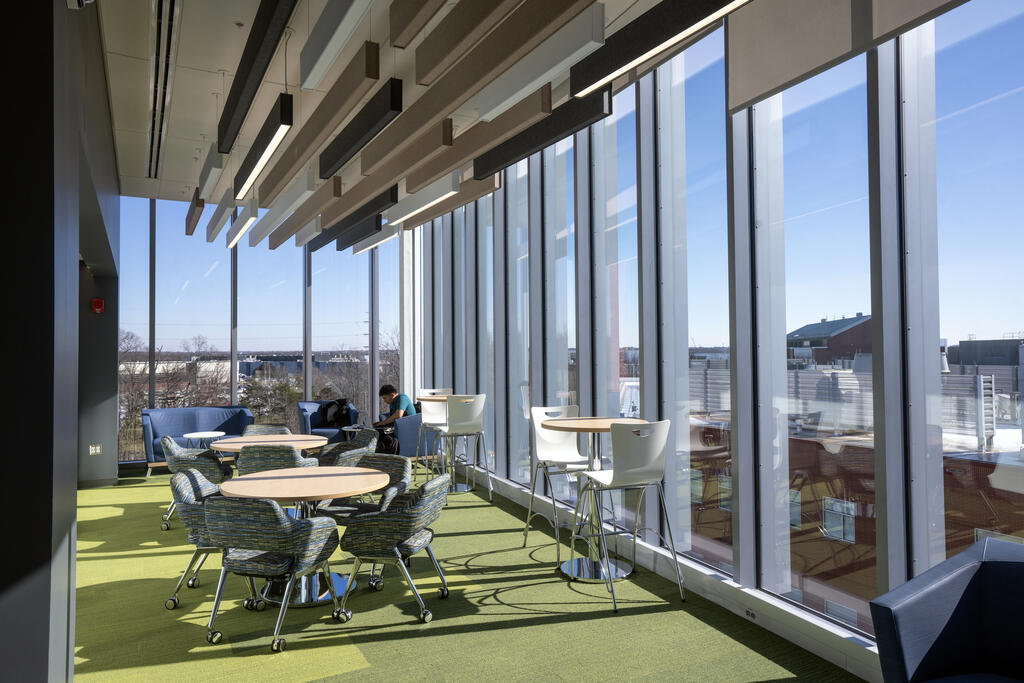Admission CTAs
Red pandas on red alert: Mason student, alumni conduct research to save endangered species
Saving an endangered species is possible, but it takes a village. Conservationists, including three George Mason University alumni working at the Smithsonian and a current student, are part of the team at the Smithsonian Conservation Biology Institute (SCBI) and the Smithsonian-Mason School of Conservation (SMSC) working to ensure red pandas move off the endangered list.
“Our main focus is breeding, expanding the population and looking at genetics,” said SCBI’s carnivore curator Juan Rodriguez, BS Biology ’09. In the event that something catastrophic happens in the wild, their goal is to have a genetically viable population in captivity to stave off extinction, he said.
Rodriguez and his team help produce red panda and clouded leopard cubs and maned wolf pups, he said. This year, 4-year-old red panda Moonlight gave birth in June.
Moonlight's new cub was born in June. Photo by Jessica Kordell/Smithsonian Conservation Biology Institute.
Since April 2018, Monika Conrad, an environmental science and policy graduate student, has been conducting behavioral research on the red pandas, including Moonlight and her cub, at SCBI and the National Zoo as part of her master’s program.
“The idea is to understand what disturbs red pandas, what changes their behaviors and their physiology, to see what may negatively impact welfare,” said Conrad, who also assists the undergraduate students in their research at SMSC. “If we can give them the best possible welfare, we can improve breeding success.”
Conrad, who came to Mason after learning about Mason School of Integrative Studies professor and Mason alumna Elizabeth Freeman’s red panda research during a Smithsonian internship, spent 14 months observing the animals and logging their behaviors. She also recorded the climate (temperature, humidity and wind speed), noise levels, and zoo visitor numbers to see if and how these environmental factors influence red pandas.
This semester Conrad spends her days in the SCBI endocrine lab, extracting hormones from the red panda’s fecal samples. Later, she’ll analyze the behavioral data with the hormone concentrations to see if there are connections between the two.
Jessica Kordell, who has been an animal keeper at Smithsonian since 2007, helped hand-raise Moonlight when she was a cub, and continues to provide care for SCBI’s red pandas and clouded leopards. The Mason alumna, who earned her master’s in environmental science and policy in 2017 and studied under Professor Freeman, also mentors undergraduate practicum students attending SMSC.
Working with the young cubs and educating students are the most rewarding parts of her job, Kordell said.
“The work that we do here, both with the students and with the animals day-to-day, really matters because we are in this stage where if we don’t work hard to save them or save their environment, [the species] could be gone,” Kordell said.
Kordell said her Mason experience was significant for her career.
From courses on climate change to learning about collecting genetic samples noninvasively, her classes “really helped me understand more about what I do as a professional and how that actually helps save our species.”
The preservation extends beyond the animals, since each species plays a unique role in the ecosystem and in everyone’s survival, Kordell and Rodriguez agreed.
“Students like Monika are excellent for what we do,” Rodriguez said. “It’s really very fulfilling to see that such a younger generation is ready to go out there and preserve these amazing species.”
Conrad and undergraduate students at SMSC work directly with scientists who are at the forefront of conservation research. It’s an unparalleled experience, as most students would otherwise learn about these topics from books or videos, Rodriguez said.
“It’s amazing to be here as a student,” Conrad said. Both the Smithsonian scientists and Mason professors are eager to answer questions and inspire the next generation of conservationists, she said.
“[You’re] never going to be able to find another program that can really immerse [you] in conservation like coming to SMSC will,” Conrad said. “I love that I’ve been able to have this opportunity—not just the knowledge, but the opportunities to connect with these researchers and learn more.”
Monika Conrad performs a behavioral observation of red pandas at SCBI. Photo by Evan Cantwell/George Mason University.
Moonlight and her cub play at SCBI. Photo by Evan Cantwell/George Mason University.
Monika Conrad and Jessica Kordell are part of the team working to ensure red pandas move off the endangered list. Photo by Evan Cantwell/George Mason University.
Monika Conrad works in the endocrine lab, extracting hormones from red panda fecal samples. Photo by Evan Cantwell/George Mason University.
Moonlight's new cub. Photo by Evan Cantwell/George Mason University.
Topics: Smithsonian-Mason School of Conservation, Smithsonian's National Zoo and Conservation Biology Institute, Smithsonian Conservation Biology Institute (SCBI), Smithsonian, Department of Environmental Science and Policy (ESP), Mason Alumni, Conservation, Conservation Biology
